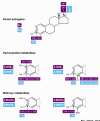Metabolic inactivation of estrogens in breast tissue by UDP-glucuronosyltransferase enzymes: an overview
- PMID: 15535854
- PMCID: PMC1064083
- DOI: 10.1186/bcr936
Metabolic inactivation of estrogens in breast tissue by UDP-glucuronosyltransferase enzymes: an overview
Abstract
The breast tissue is the site of major metabolic conversions of estradiol (E2) mediated by specific cytochromes P450 hydroxylations and methylation by catechol-O-methytransferase. In addition to E2 itself, recent findings highlight the significance of 4-hydroxylated estrogen metabolites as chemical mediators and their link to breast cancer development and progression, whereas, in opposition, 2-methoxylated estrogens appear to be protective. Recent data also indicate that breast tissue possesses enzymatic machinery to inactivate and eliminate E2 and its oxidized and methoxylated metabolites through conjugation catalyzed by UDP-glucuronosyltransferases (UGTs), which involves the covalent addition of glucuronic acid. In opposition to other metabolic pathways of estrogen, the UGT-mediated process leads to the formation of glucuronides that are devoid of biologic activity and are readily excreted from the tissue into the circulation. This review addresses the most recent findings on the identification of UGT enzymes that are responsible for the glucuronidation of E2 and its metabolites, and evidence regarding their potential role in breast cancer.
Figures


Similar articles
-
Disturbance of Mammary UDP-Glucuronosyltransferase Represses Estrogen Metabolism and Exacerbates Experimental Breast Cancer.J Pharm Sci. 2017 Aug;106(8):2152-2162. doi: 10.1016/j.xphs.2017.04.073. Epub 2017 May 4. J Pharm Sci. 2017. PMID: 28479355
-
Recent insight on the control of enzymes involved in estrogen formation and transformation in human breast cancer.J Steroid Biochem Mol Biol. 2005 Feb;93(2-5):221-36. doi: 10.1016/j.jsbmb.2005.02.007. J Steroid Biochem Mol Biol. 2005. PMID: 15860265 Review.
-
Glucuronidation of hydroxylated polybrominated diphenyl ethers and their modulation of estrogen UDP-glucuronosyltransferases.Chemosphere. 2012 Feb;86(7):727-34. doi: 10.1016/j.chemosphere.2011.10.047. Epub 2011 Nov 26. Chemosphere. 2012. PMID: 22119418
-
Stimulation of estradiol glucuronidation: a protective mechanism against estradiol-mediated carcinogenesis?Mol Nutr Food Res. 2006 Apr;50(4-5):385-9. doi: 10.1002/mnfr.200500198. Mol Nutr Food Res. 2006. PMID: 16598814
-
Roles of UDP-glucuronosyltransferases in chemical carcinogenesis.Crit Rev Biochem Mol Biol. 1991;26(2):129-50. doi: 10.3109/10409239109081125. Crit Rev Biochem Mol Biol. 1991. PMID: 1914494 Review.
Cited by
-
Bioanalytical LC-MS Method for the Quantification of Plasma Androgens and Androgen Glucuronides in Breast Cancer.J Chromatogr Sci. 2016 Apr;54(4):583-92. doi: 10.1093/chromsci/bmv190. Epub 2016 Jan 12. J Chromatogr Sci. 2016. PMID: 26762957 Free PMC article.
-
Genetic Association of rs2237572 Cyclin-Dependent Kinase 6 Gene with Breast Cancer in Iraq.Indian J Clin Biochem. 2021 Jul;36(3):304-311. doi: 10.1007/s12291-020-00895-5. Epub 2020 Jun 8. Indian J Clin Biochem. 2021. PMID: 34220005 Free PMC article.
-
Circulating 2-hydroxy- and 16alpha-hydroxy estrone levels and risk of breast cancer among postmenopausal women.Cancer Epidemiol Biomarkers Prev. 2008 Aug;17(8):2029-35. doi: 10.1158/1055-9965.EPI-08-0262. Cancer Epidemiol Biomarkers Prev. 2008. PMID: 18708395 Free PMC article.
-
Identification of naturally occurring inhibitors in Xian-Ling-Gu-Bao capsule against the glucuronidation of estrogens.Front Pharmacol. 2022 Aug 4;13:935685. doi: 10.3389/fphar.2022.935685. eCollection 2022. Front Pharmacol. 2022. PMID: 35991901 Free PMC article.
-
Estrogen metabolite ratio: Is the 2-hydroxyestrone to 16α-hydroxyestrone ratio predictive for breast cancer?Int J Womens Health. 2011 Feb 8;3:37-51. doi: 10.2147/IJWH.S7595. Int J Womens Health. 2011. PMID: 21339936 Free PMC article.
References
-
- Key TJ. Serum oestradiol and breast cancer risk. Endocr Relat Cancer. 1999;6:175–180. - PubMed
-
- Endogenous Hormones and Breast Cancer Collaborative Group Endogenous sex hormones and breast cancer in postmenopausal women: reanalysis of nine prospective studies. J Natl Cancer Inst. 2002;94:606–616. - PubMed
-
- Castagnetta LA, Granata OM, Traina A, Ravazzolo B, Amoroso M, Miele M, Bellavia V, Agostara B, Carruba G. Tissue content of hydroxyestrogens in relation to survival of breast cancer patients. Clin Cancer Res. 2002;8:3146–3155. - PubMed
Publication types
MeSH terms
Substances
LinkOut - more resources
Full Text Sources

